Solving Pressing Challenges: 3D Printing of Medical Grade Face Shields
Duke's COVID-19 engineering response team springs into action
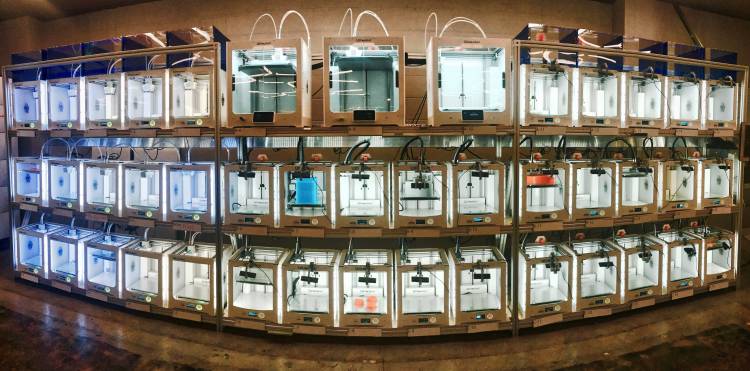
As medical care providers on the front lines deliver patient care during the COVID-19 pandemic, a Duke task force is also working to ensure Duke Health does not experience a medical equipment supply shortage similar to hospitals around the country. The task force comprising Duke engineers, medical and technology professionals developed a reusable medical face shield using Duke’s 3D printing technology.
“Duke is really a special place in that we can bring together folks from all these departments so quickly and mobilize them quickly, and that the relationships already exist, is really unique.” —Eric Richardson, Duke Biomedical Engineering
When social-distancing began in mid-March to stop the spread of the novel coronavirus, Duke engineering professors Ken Gall, Paul Fearis and Eric Richardson began considering how to quickly address the needs arising from the disease. They gathered colleagues from the Pratt School of Engineering’s Engineering Entrepreneurship (EngEn) team and fellows in Richardson’s Duke Design Health course to begin exploring designs for medical devices that could help amid the supply shortages. The unusual design program attracts students from Duke’s School of Medicine, Nursing, Fuqua and Trinity as well as Duke Engineering.
As the Duke Engineering team mobilized, Duke’s Innovation Co-Lab in the Office of Information and Technology was considering how to use its state-of-the-art 3D printing lab equipped with more than five dozen printers to address the same supply shortage. Chip Bobbert, Co-Lab’s Sr. Engineer & Fabrication Architect, had already taken the lead role in investigating best use cases for this technology and quickly partnered to help create the 15-member COVID-19 Design task force. They began a series of on-going late night conversations on WebEx or Zoom to tackle the pressing problem.
 “Duke is really a special place in that we can bring together folks from all these departments so quickly and mobilize them quickly, and that the relationships already exist, is really unique,” said Richardson. “The collaborative nature of Duke, that’s been, I think, a real big help.”
“Duke is really a special place in that we can bring together folks from all these departments so quickly and mobilize them quickly, and that the relationships already exist, is really unique,” said Richardson. “The collaborative nature of Duke, that’s been, I think, a real big help.”
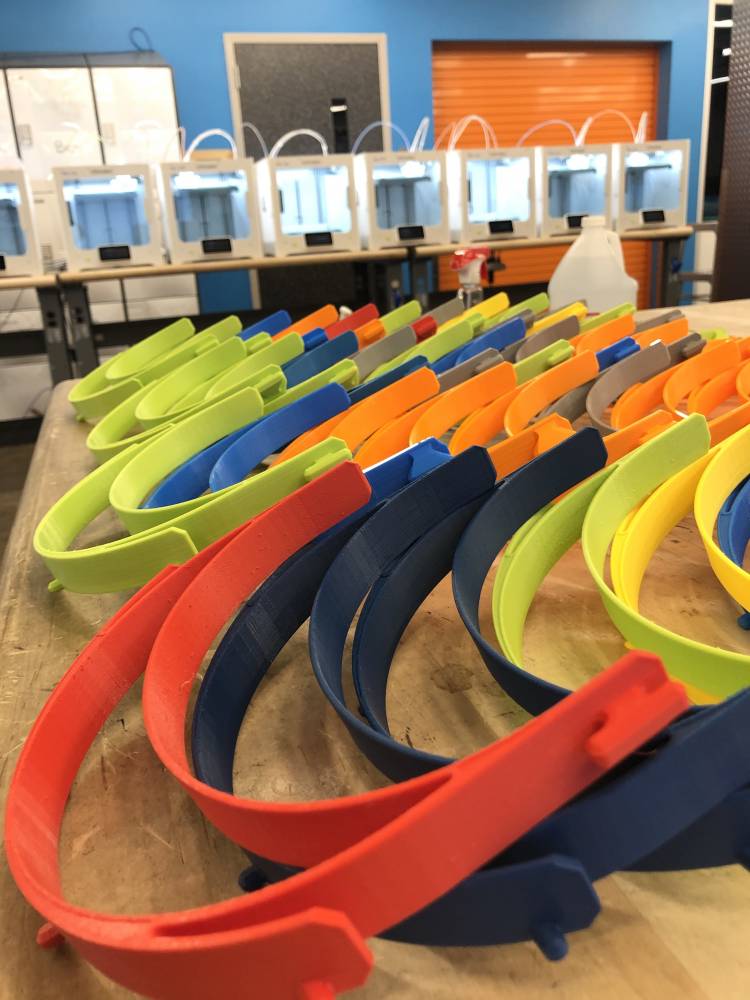 While the pandemic created an urgent need for additional medical supplies, members of Duke Engineering, OIT and Duke Health were methodical and thorough in their approach. They began by talking with health care workers and assessing equipment priorities. When it became evident a reusable medical face shield would be helpful, the task force began running printing tests on different prototypes. After a week of testing about 100 designs, the task force landed on its prototype of a 3D printed headband that forms a face shield when attached to a laser-cut polycarbonate lens, which is a light weight piece of plastic with high-impact resistance.
While the pandemic created an urgent need for additional medical supplies, members of Duke Engineering, OIT and Duke Health were methodical and thorough in their approach. They began by talking with health care workers and assessing equipment priorities. When it became evident a reusable medical face shield would be helpful, the task force began running printing tests on different prototypes. After a week of testing about 100 designs, the task force landed on its prototype of a 3D printed headband that forms a face shield when attached to a laser-cut polycarbonate lens, which is a light weight piece of plastic with high-impact resistance.
Donna Crenshaw, executive director of Duke MEDx, the collaborative venture of the Duke School of Medicine and the Pratt School of Engineering, said these face shields will serve as protection from contamination for health care workers and also help preserve a very limited resource, the N95 respirator masks.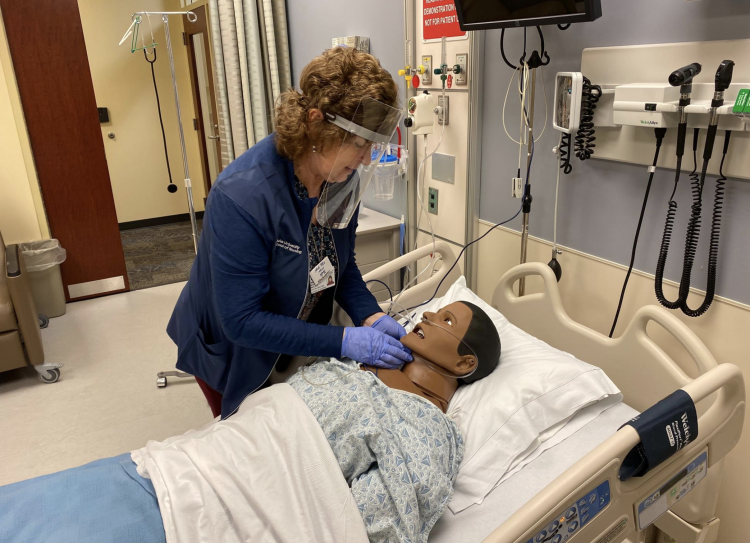
“It is an extra level of safety for the person who is dealing with a COVID patient or somebody who may have COVID, so it’s an extra barrier, said Crenshaw. “The other thing is, it’s a mechanism for helping to preserve the really important respirators, the N95 masks, that those providers are wearing. So, it really saves them from being contaminated.”
“The thing I’m most proud of is that we’ve really walked a fine line here on the timing. We’re seeing nationally that moving too quickly in this space leads to unusable designs and products, but frankly there is also no time to run things through 100% of the usual processes and revisions.” —Evan Levine, Senior Director of Academic Technology, Duke OIT
WORKING TO SOLVE A PROBLEM
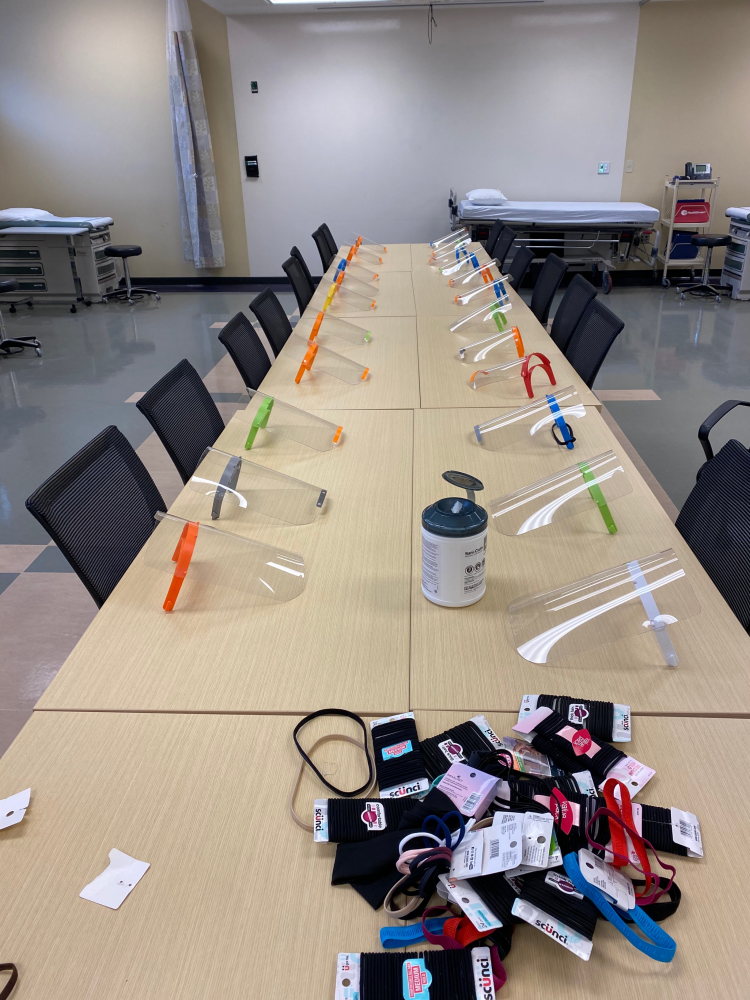 More than two dozen Duke nurses, graduate nursing students, and medical professionals tested the 3D printed face shields in a simulation lab and determined they met safety standards and can be sanitized for re-use.
More than two dozen Duke nurses, graduate nursing students, and medical professionals tested the 3D printed face shields in a simulation lab and determined they met safety standards and can be sanitized for re-use.
“The thing I’m most proud of is that we’ve really walked a fine line here on the timing. We’re seeing nationally that moving too quickly in this space leads to unusable designs and products, but frankly there is also no time to run things through 100 percent of the usual processes and revisions,” said Evan Levine, Senior Director of Academic Technology for OIT.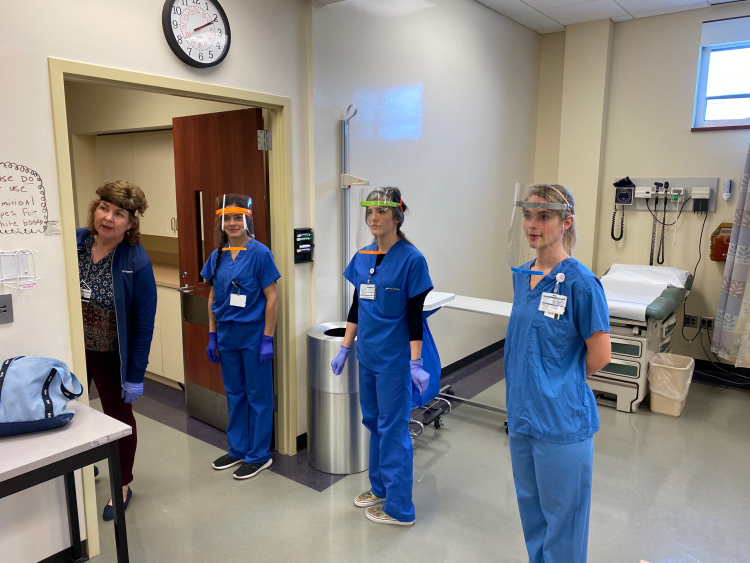
“I see this product benefitting hugely from our ability to learn from others, make a number of important revisions within just a few days time, and still begin production in real numbers quickly enough to meet the demand of our health care professionals.
WHAT SUCCESS LOOKS LIKE
Duke is partnering with UNC-Chapel Hill on producing the face shields, which will be distributed at both Duke and UNC Health Systems.
While 65 Duke printers have been continuously churning to produce 1,000 3D printed headbands, the process is time consuming. When the shields are produced in house by the universities, an individual print can take as long as 4 hours. Since the need is high for rapid turnout of the shields, Duke and UNC plan to turn the production of the final design over to manufacturing facilities in the coming days, where thousands of shields will get created each day.
“The joke is that ‘You know times are tough when UNC and Duke are walking hand in hand,'” said Chip Bobbert, digital media and engineering technologies engineer with OIT. “Together we’re winning. We will split the manufacturing runs 50/50. Once mass manufacturing begins, we anticipate no shortages and plenty for both.”
OVERCOMING CHALLENGES
Developing the right shield was not a simple problem to solve. The task force saw reports of other 3D medical masks getting printed at homes, in basements or other locations amid the equipment shortage that ultimately wound up breaking or cracking after they were handed over to health care workers. Duke’s rigorous testing ensures the equipment is created at the highest standards.
As the task force worked, it received an outpouring of inquiries from community members offering to print their own medical face masks, barriers and shields on the university’s printers using designs they found online. While the offer for help is appreciated, the task force has the staff and resources at Duke to run these devices through proper tests that ensure they’re made safely.
“We’re trying to be very deliberate about setting up a good quality system, and really doing rigorous testing. So that whatever comes out from our team, and has some assurance that it’s going to work and it’s going to work well and we have the appropriate documentation and appropriate approvals. And that’s the thing we’ve seen is really needed right now, because there’s just tons of DIY designs,” Richardson said.
MORE AID TO COME
In addition to the medical shields, the COVID-19 Engineering Team has been working to engineer and produce a wide range of much-needed equipment, from respirator hoods for medical workers, to bed tents to isolate infectious patients, to 3D-printed “splitters” that make a single ventilator work for more than one patient. The team is working with ORAQ and DUHS compliance to ensure that the devices undergo engineering and usability tests, a risk analysis, and approvals through the health system before being used with patients.
“Necessity is the mother of invention, this group is amazingly productive,” Bobbert said.
“In the past couple of years we have assembled a very creative and capable team of engineers with extensive industry experience in medical device design, who have already been working closely with Duke clinicians,” said Ken Gall, associate dean for entrepreneurship at Duke Engineering and associate director of Duke MEDx. “Our EngEn team has pivoted quickly to work with our Duke Health colleagues on COVID-19 solutions and support—as they identify needs, we’re working to evaluate and prioritize ways we can help.”
Donna Crenshaw said it’s been inspiring to see how quickly and effortlessly the different units have come together to aid caregivers responding on the front lines to the pandemic.
“I really would like to be able to look back one day and say, ‘I helped in some small way.’”
